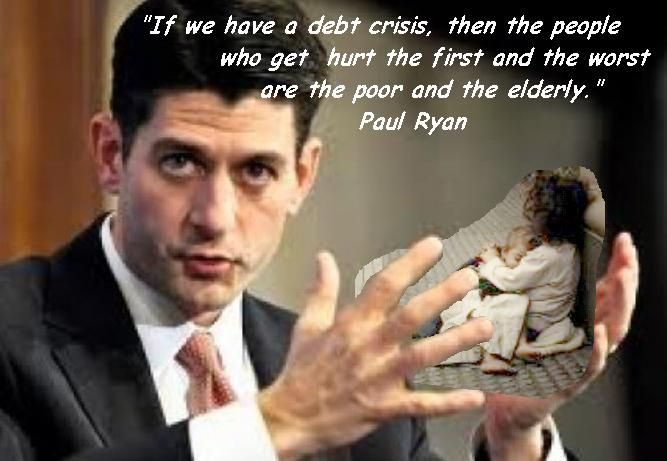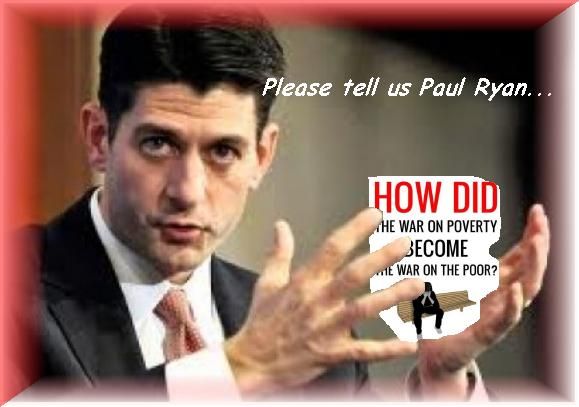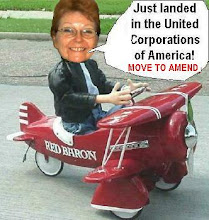Paul Ryan's Violence.
Tell Us Paul Ryan,
How did the war on poverty become the war on the poor?

EXCERPT: Hurricane Katrina rolled over the Gulf Coast and unearthed an unpleasant truth about the state of poverty in this country: concentrated poverty still exists. Isolated deep in inner-city neighborhoods were hundreds of thousands of poor households that lacked the means to evacuate or weather the storm. But even without hurricanes, the problems associated with concentrated poverty affect more than 3.5 million poor people – 8 million total, if you include the non-poor – who live in such neighborhoods.As of the year 2000, about one-tenth of the nation’s poor lived in neighborhoods with poverty rates of 40 percent and higher. Among poor minorities, the share was an even greater 15 percent, including 19 percent of poor African Americans. The problems that arise from concentrated poverty are not just limited to those that occur after natural disasters. A number of economic and social ills prevail, including the ABSENCE of quality education and work opportunities, which can lead to high rates of unemployment, crime and school dropouts. From a housing perspective, high poverty areas are more likely to have deteriorating and/or abandoned properties, which discourage investment in the area. This leads to a downward spiral for the neighborhood, from which it is costly and difficult to recover. Thus, it is not just the poor who live in concentrated poverty that suffer, but all households in these neighborhoods.Residents of high poverty areas often earn incomes so low that they cannot afford even the rents and housing costs on the dilapidated units in their neighborhoods. In 2000, almost a third of households in these areas still paid at least half their income for housing, in spite of living in some of the worst housing conditions.While still high for residents, these rents are often not enough for many landlords to cover the maintenance and operating costs on their properties. A number of property owners in these neighborhoods neglect their buildings, leaving them to deteriorate to near-uninhabitable conditions. Spread over an entire neighborhood, such abandonment of property can destabilize an area, by discouraging other owners and would-be investors from spending money to improve and bring services to the area.

Weingart Center | Homeless nonprofit charity
And what is Paul Ryan’s defense for such drastic cuts to the poor while giving additional handouts to the rich? He wants to help the poor by stomping on them…
“If we have a debt crisis, then the people who get hurt the first and the worst are the poor and the elderly.”
That’s all you need to know to understand how and why Ryan came up with his budget plan. But here are the specifics.
After recalling his family’s immigration from Ireland generations ago, and his belief in the virtue of people who “pull themselves up by the bootstraps,” Ryan warned that a generous safety net “lulls able-bodied people into lives of complacency and dependency, which drains them of their very will and incentive to make the most of their lives. It’s demeaning.”
HOW VERY KIND OF MR. RYAN: To protect poor Americans from being demeaned, Ryan is cutting their anti-poverty programs and using the proceeds to give the wealthiest Americans a six-figure tax cut.
The Ryan budget plan is full of holes and missing key explanations for his wacky math. In one instance, Ryan proposes putting financial aid for college on “a sustainable funding path” instead of admitting that he completely slashes most financial aid for higher education. His plan states giving average workers “the tools to thrive in the 21st century” instead of saying that he’s cutting most job-training programs.
Other highlights of Ryan’s budget plan:
Cut 25% from transportation and infrastructure spending (including cuts to Air Traffic Control
Cut 13% on spending for Veterans
Cut 6% on spending for “general science, space, and basic technology”
Cut 33% on spending for “education, training, employment, and social services”
Cut 14.6% on spending for protecting the environment (including cuts to weather forcasting related to emergency warnings and hurricane response)
Cuts to EPA and Food Safety
It’s estimated that Ryan’s plan would grow the national debt by $4 trillion over his 10-year plan. That’s because he’s going to give additional tax cuts to the wealthy, lower the already basement level corporate tax rate, and allow all those corporations and wealthy individuals to bring their money home from offshore and foreign accounts without having to pay taxes.

Why Is There Poverty?Following the course of major social problems such as poverty, drug abuse, violence, and oppression, it often seems that nothing works. Government programs come and go as political parties swing us back and forth between stock answers whose only effect seems to be who gets elected. If anything, the problems get worse, and people feel increasingly helpless and frustrated or, if the problems don’t affect them personally, often feel nothing much at all.
As a society, then, we are stuck, and we’ve been stuck for a long time. One reason we’re stuck is that the problems are huge and complex. But on a deeper level, we tend to think about them in ways that keep us from getting at their complexity in the first place. It is a basic tenet of sociological practice that to solve a social problem we have to begin by seeing it as social. Without this, we look in the wrong place for explanations and in the wrong direction for visions of change.
Consider, for example, poverty, which is arguably the most far-reaching, long-standing cause of chronic suffering there is. The magnitude of poverty is especially ironic in a country like the United States whose enormous wealth dwarfs that of entire continents. More than one out of every six people in the United States lives in poverty or near-poverty. For children, the rate is even higher. Even in the middle class there is a great deal of anxiety about the possibility of falling into poverty or something close to it – through divorce, for example, or simply being laid off as companies try to improve their competitive advantage, profit margins, and stock prices by transferring jobs overseas.
How can there be so much misery and insecurity in the midst of such abundance? If we look at the question sociologically, one of the first things we see is that poverty doesn’t exist all by itself. It is simply one end of an overall distribution of income and wealth in society as a whole. As such, poverty is both a structural aspect of the system and an ongoing consequence of how the system is organized and the paths of least resistance that shape how people participate in it.
The system we have for producing and distributing wealth is capitalist. It is organized in ways that allow a small elite to control most of the capital – factories, machinery, tools – used to produce wealth. This encourages the accumulation of wealth and income by the elite and regularly makes heroes of those who are most successful at it – such as Microsoft’s Bill Gates. It also leaves a relatively small portion of the total of income and wealth to be divided among the rest of the population. With a majority of the people competing over what’s left to them by the elite, it’s inevitable that a substantial number of people are going to wind up on the short end and living in poverty or with the fear of it much of the time. It’s like the game of musical chairs: Since the game is set up with fewer chairs than there are people, someone has to wind up without a place to sit when the music stops.
In part, then, poverty exists because the economic system is organized in ways that encourage the accumulation of wealth at one end and creates conditions of scarcity that make poverty inevitable at the other. But the capitalist system generates poverty in other ways as well. In the drive for profit, for example, capitalism places a high value on competition and efficiency. This motivates companies and their managers to control costs by keeping wages as low as possible and replacing people with machines or replacing full-time workers with part-time workers. It makes it a rational choice to move jobs to regions or countries where labor is cheaper and workers are less likely to complain about poor working conditions, or where laws protecting the natural environment from industrial pollution or workers from injuries on the job are weak or unenforced. Capitalism also encourages owners to shut down factories and invest money elsewhere in enterprises that offer a higher rate of return. MORE HERE: http://www.agjohnson.us/essays/poverty/

Labels: 2012, Ayn Rand, GOP, liberal, Obama, Paul Ryan, political, poor, poverty, Romney, tea party, violence, VP, war







<< Home